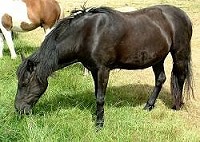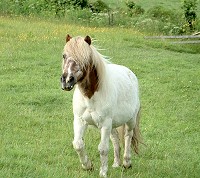Beacon Villages

Under Cosdon Beacon Dartmoor Devon UK
Dartmoor Ponies - Breeds Then and Now |
||||
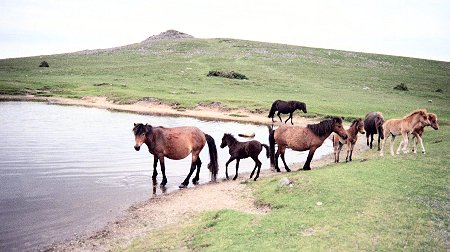 |
||||
Dartmoor ponies are known as the ‘Spirit of the Moor', a reflection of the fact that they have been an integral part of the landscape and life of Dartmoor for thousands of years. Hoof prints of ponies dating from 3,500 years ago have been recorded and the earliest written record, in AD 1012, speaks of the “wild horses” of Ashburton who were owned by the Bishop of Crediton. The history of the moor has been carried on the back of the Dartmoor Pony, sometimes quite literally! In medieval times, when there were virtually no wheeled carts in use on Dartmoor, the ponies were used as pack animals to transport goods and as riding ponies to transport people. In fact, up until the second half of the 20th century they were used extensively in nearly every facet of the working and social life on Dartmoor. This was equally true for the people living in and around the Beacon villages where the ponies worked alongside villagers on the farm, making deliveries and doubling up to provide riding and driving ponies for the family. |
||||
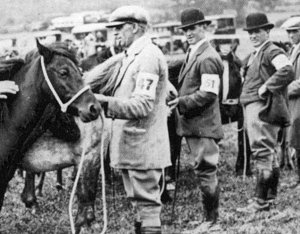 |
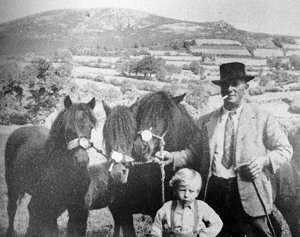 |
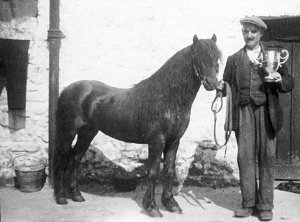 |
||
Jim Holman, from South Zeal, and his family have been involved in the breeding of pure bred Dartmoor ponies for many years. His ponies are of a traditional type whose quality and good temperament have consistently put them amongst the Champions and award winners in shows in the UK and abroad. An ancestor of Clarence White, another South Zeal family, can also be seen here with a prize winning Dartmoor. Today the ponies, which can be seen on the moor all year round, are listed as an endangered species - their numbers having plummeted from about 30,000 in 1950 to fewer than 2,000. They fall, broadly, into three main types: |
||||
The ‘Moorland’ pony type This is the type most frequently seen on the moor. They usually run in small mixed breed herds of up to ten mares and their youngsters with a stallion. Although many of these ponies look very similar to the pure-bred Dartmoor, because they run free it is impossible to prove their parentage. |
The‘Registered’ Dartmoor Pony
|
The Dartmoor Hill (Shetland) pony type Dartmoor ponies were crossed with Shetlands early in the 20th century to produce small, strong, animals capable of working down the coal mines of northern England and Wales. Today these coloured ponies, although not a recognised breed, are still bred because there is a demand for them as children’s ponies. |
||
| The Dartmoor Pony Year | ||||
| Spring Foals are usually born between May and August. (most of them in the spring) and on April 1st, last year's filly foals are allowed back on the commons to join them. The Dartmoor Commoners have tightened up the rules regarding breeding on the moor. Anyone found releasing non attested stallions risks prosecution and removal of their animals. These are branded on the off-side haunch with a circle with a cross in it. |
||||
| Summer Summertime is spent foraging for food on the commons, roaming within their lears( their own territories). The biggest risk to these ponies is from motorists, a risk that is increased by well meaning but misguided visitors to the moor who encourage the ponies to the roadside by offering tasty tit-bits. It is illegal to feed the ponies on the moor. The Dartmoor Pony Moorland Scheme was developed to improve the health and quality of the Moorland Dartmoor ponies. Approved mares spend the summer running with a registered stallion in one of the 'newtakes' (special enclosures) where there is public access, or where they can be seen on a National Park guided walk. |
||||
| Autumn This is the time when the local farmers who keep ponies get together to clear them off the commons. These round ups are called “drifts” and are held in late September and early October.The ponies are herded into enclosures where each owner sorts out their ponies and drives them home to mark the foals and wean them, or sell them. They are checked for good health and then the mares and the foals that are being kept can run back to their 'lear' on the common until winter. |
||||
| Winter Now the ponies go to their winter 'lear', sheltered areas where they are out of the biting wind and where furze is more plentiful. By the 1st January the foals born during the previous year must be taken off the open commons because this is the time when bad winter weather is likely to set in. The colt foals must remain off the commons until after they are two years old. They may then only go back if they have been approved as a stallion, or castrated. To prevent young filly foals mating too young, they too must come off the commons in their first year. They must stay off until the following year. |
||||
